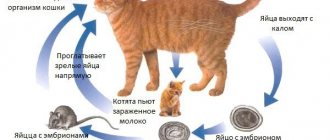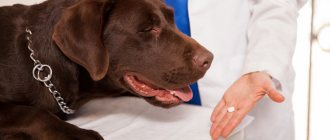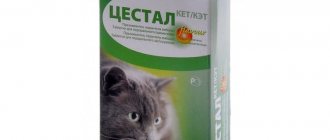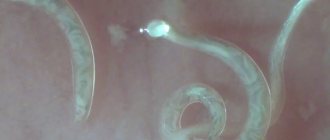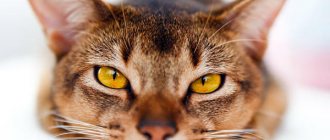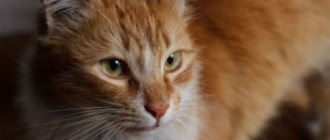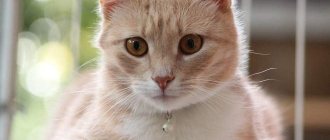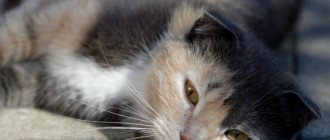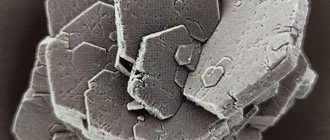- VetConsultPlus
- Informational portal
- Veterinary drug
- Name: Milbemax tablets with meat flavor for cats and kittens
- Latin name: MILBEMAX
- Type of drug: anthelmintic
- Manufacturer: Novartis
- Active ingredients: milbemycin oxime and praziquantel
- Release form: Beige tablets for small cats and kittens - 4 mg of milbemycin and 10 mg of praziquantel. Red tablets for large cats - milbemycin 16 mg and praziquantel 40 mg
- Prevention: dirofilariasis, pulmonary and intestinal nematodes
- The frequency of use of Milbemax for cats is from 1 time per month to 4 times a year, depending on the epizootological situation. Company: Novartis Animal Health Canada Inc.
Dosing of the drug for adult cats
Milbemax coated tablets for large cats 16 mg milbemycin oxime and 40 mg praziquantel per tablet (reddish, brown, oblong tablets)
- 2 – 4 kg – ½ tablet (red)
- 4 – 8 kg – 1 tablet (red)
- 8 – 12 kg – 1 + ½ Milbemax tablets (red)
According to the instructions for use, the minimum recommended dose is 2 mg/kg milbemycin oxime and 5 mg/kg praziquantel. Cats weighing more than 8 kg should be given a combination of tablets appropriate for their body weight.
To prevent dirofilariasis, use Milbemax once a month on the same day.
To prevent heartworm disease, the initial dose should be given within one month after the first sign of mosquito activity and regular administration of Milbemax should continue for at least another month after the end of the mosquito season. If the interval between doses exceeds 30 days, the effectiveness of Milbemax may be significantly reduced. If regular monthly treatment is delayed, it is important to resume treatment immediately at the recommended dosage. If treatment has been delayed for more than two months, a veterinarian should be consulted.
For hookworm, intestinal nematode and tapeworm infestations, control will be combined with heartworm prophylaxis or Milbemax alone. Kittens should be treated at 6, 8, 10 and 12 weeks of age, then monthly until 6 months of age. In endemic areas where heartworm disease is not present, adult cats should be treated 4 times per year or as directed by a veterinarian.
Contraindications
Contraindications to the use of Milbemax are as follows:
- Kittens less than 6 weeks old or weighing less than 0.5 kg.
- Adult cats weighing less than 2 kg.
- General exhaustion of the body.
- Infectious diseases.
- Liver dysfunction.
- Renal dysfunction.
- Individual intolerance to the active components of the drug.
- Pregnant cats, in the first two thirds of the period.
- Nursing cats, in the first 3 weeks after birth.
Security Research
Complex drug - Praziquantel / Milbemycin oxime:
Targeted animal safety studies in adult cats showed that Milbemax was well tolerated at doses up to 5 times the recommended dose. At the minimum recommended dose rate of 6.5 times (milbemycin oxime 13 mg/kg, praziquantel 33 mg), one in eight cats had reversible tremor. This reaction was mild and transient.
MILBEMAX was well tolerated in 6-week-old kittens when administered at the recommended dose once a week for seven treatments (twice the recommended frequency).
Milbemycin oxime:
Milbemycin oxime
has been successfully tested on over 8 different breeds of cats and kittens two weeks of age and older. In a clinical field study, 310 cats completed treatment with milbemycin oxime. Milbemycin oxime has been safely administered to animals receiving commonly used veterinary medications such as vaccines, anthelmintics, anesthetics, antibiotics, steroids, flea collars, shampoos, and wipes.
Safety studies were conducted on young cats and kittens starting at two weeks of age. The 1X, 3X and 5X doses showed no drug-related effects. Tolerability studies at exaggerated doses of 10X also showed no drug-related adverse effects in kittens and young adult cats.
Reviews from veterinarians
Alexander, Samara
I recommend giving pink tablets to kittens during their morning feeding. At this time of day, the kitten feels hunger more acutely, so it can eat the medicine without foaming and belching, which often accompany taking cheap medicines. In addition, at this time the metabolic processes in the body are most active, so the concentration of the drug in the blood will reach its peak after two hours.
Sergey, Kirov
I advise you to give Milbemax with a small amount of food. It is optimal to roll the tablet into a minced ball. In this case, the animal will quickly eat it. Besides, if you feel sick, it won’t be too bad.
Sofia, Ekaterinburg
The medicine has proven itself in the treatment of nematodes and cestodes. The undoubted advantage is that a re-appointment after two weeks is not required. This is convenient for both owners and pets.
Anna, Omsk
I have recently worked in a veterinary clinic, but I can confirm that Milbemax is well tolerated. Animals do not feel sick or feel tired. For the owners, everything looks as if nothing is happening. The cat is active and behaves cheerfully.
All information posted on the site is provided in accordance with the User Agreement and is not a direct instruction to action. We strongly recommend that before using any product, you must obtain a face-to-face consultation at an accredited veterinary clinic.
Dirofilariasis in cats
Most of the severe pathological changes caused by feline heartworm disease occur before any outward signs of the disease appear, and these signs can be quite variable. Prevention of the disease is very important and more effective than therapy.
The disease is caused by Dirofilaria immitis, which lives in the right side of the heart and adjacent blood vessels. A cat not receiving preventive medications may become infected with this disease. Adult worms cause the disease by damaging blood vessels in the lungs, which prevents normal blood flow. This can cause increased stress on the heart, which can lead to heart failure. Adult worms can also migrate to other tissues of the central nervous system, such as the brain. Prevention of cats with Milbemax is effective, oral administration according to the instructions.
The disease is spread from animal to animal by any of more than 70 species of mosquitoes. Adult heartworms release larval forms (microfilariae) into the cat's bloodstream. The mosquito becomes infected by ingesting these microfilariae when it feeds on the blood of an infected cat; Over the next two to three weeks, these microfilariae grow and molt twice inside the mosquito to reach an infective stage that invades another cat after the mosquito bites them. In a cat, these larvae grow, move towards the heart, mate and begin the cycle again.
Pharmacological properties
Praziquantel and milbemycin oxime exhibit synergistic action and together have a wide spectrum of action on mature and larval forms of cestodes and nematodes. Milbemycin oxime belongs to the group of macrocyclic lactones, which are released as a result of the enzymatic activity of Streptomyces hygroscopicus var. Aureolacrimosus. Milbemycin oxime is active against the larvae of the nematode Dirofilaria immitis, as well as nematodes parasitizing the gastrointestinal tract of cats. Milbemycin increases the permeability of cell membranes to chlorine ions, this leads to overpolarization of the cell membranes of muscle and nervous tissue, paralysis and death of the parasite. The maximum concentration of milbemycin oxime in blood plasma is achieved 2 hours after administration of the drug. The half-life is approximately 13 hours after oral administration of the drug; the compound is excreted from the body mainly unchanged. The second component, praziquantel, is an acylated derivative of pyrazine isoquinoline and has a pronounced effect against nematodes and cestodes. Praziquantel, increasing the permeability of the parasite's cell membranes to calcium ions, causes destruction of the tegument, muscle contraction and membrane depolarization, which leads to the death of the parasite and helps eliminate it from the cat's body. The maximum plasma concentration of praziquantel is achieved after 1 hour. The half-life is approximately 3 hours after oral administration, and the compound is excreted from the body primarily in the urine in the form of inactive metabolites. Milbemax belongs to the group of moderately hazardous compounds for warm-blooded animals; in recommended doses it does not have teratogenic, embryotoxic or sensitizing effects. Well tolerated by cats of different ages and breeds. The drug is highly toxic to fish and other aquatic organisms.
Features of using Milbemax for cats and kittens
This product has not been tested on breeding cats, pregnant cats, or heartworm-positive cats.
Milbemax testing:
Although the sensitivity of heartworm antigen tests is relatively low in cats, it is still considered good medical practice to test for heartworm disease before administering chemoprophylaxis for the first time, if at least 8 months have passed since the possibility of exposure, the cat should be examined veterinarian before starting treatment for cardiac heartworm disease.
What parasites does it remove?
The drug is capable of removing the following types of parasites:
- Nematodes. These helminths mainly affect the digestive system. They also like to settle in the liver. Once infected and developed, cats may experience severe coughing, vomiting, and watery, bloody stools.
- Trematodes. If your pet catches these flatworms, then his entire gastrointestinal tract will be disrupted. Therefore, the following signs will be noticeable: vomiting, bowel dysfunction, refusal to eat.
- Cestodes. Tapeworms of this type can reach a length of 140 centimeters when fully developed. If such parasites can develop to this stage, they will take a lot of useful substances from the pet, so its condition will greatly worsen.
Composition and storage conditions
Release form
Milbemax is available in the following two forms (instructions for use):
- MILBEMAX coated tablets for small cats and kittens - (4 mg milbemycin oxime and 10 mg praziquantel). Appearance: Beige to brown, oblong, dual-flavor, film-coated tablets.
- Milbemax Large Cat Flavored Tablets - (Milbemycin Oxime 16 mg and Praziquantel 40 mg). Appearance: Reddish-brown, oblong, double-flavored, flavor-coated tablets. Also available in packs of 50.
Storage conditions. Milbemax for cats should be stored at room temperature, between 15-25°C.
Company manufacturer. Novartis Animal Health Canada Inc., 2000 Argentia Road, Suite 400, Plaza 3, Mississauga, Ontario, L5N 1V9
How to give pills correctly
The tablets can be prepared accordingly before giving. This is required, however, infrequently. We have already written that flavorings, which are an important component of the medicine, make it attractive to animals. In any case, if for some reason the pet stubbornly does not want to eat the drug, proceed as follows:
- First, the tablet, placed in a porcelain cup, is crushed to a powdery state.
- After this, it is diluted with such a volume of water that a semi-liquid, homogeneous mixture is formed.
- The resulting composition is poured into the cat’s throat using a regular syringe.
Let us emphasize once again that the need to forcibly administer medication occurs extremely rarely. Usually cats eat the tablets on their own without any problems or coercion.
Prescribing Milbemax before vaccination
Unfortunately, many breeders forget that before vaccination the animal must be treated against worms. This is due to the fact that parasitic organisms secrete a huge amount of substances that can disrupt the formation of normal immunity. Accordingly, in this case, the effect of the vaccine will be either greatly reduced or completely distorted. In the latter case, there is a possibility of developing autoimmune pathologies.
To avoid such unpleasant and dangerous consequences, ten days before the expected date of vaccination, the cat is given Milbemax. In addition, before vaccination, we recommend checking the effectiveness of the antiparasitic agent by conducting a microscopic analysis of the stool. If worm eggs are found in them, the procedure must be repeated.
Learn about essential antimicrobials in animals
- Trichopolum instructions for veterinary medicine
- Instructions for the use of the antibiotic Baytril in animals
- Instructions for use of metronide
- Instructions for ceftriaxone preparations for animals
- Use of Metrogyl in veterinary medicine
- Instructions for doxycycline in animals
- Metronidazole (Metronidazole) for animals (instructions for use in veterinary medicine, doses, indications and contraindications)
- Atovaquone (ATOVAQUONE)
- Azithromycin, instructions for animal therapy
^Top
Side effects and the likelihood of their development
The manufacturer reports that side effects are extremely rare and are usually associated with individual intolerance to some of the components of the drug:
- Oppression and apathy.
- A sharp increase in salivation. The saliva is foamy and viscous, hanging in icicles from the animal’s mouth.
- It is possible to develop a “drunk” or wooden gait.
- Sometimes there is severe trembling.
- In the most severe cases - partial or complete paralysis of the limbs.
Important! Typically, such effects are not caused by individual intolerance to the drug, but by its extremely serious overdose!
In all these cases, the medication should be stopped immediately and a veterinarian should be called. The animal is given as much clean drinking water as possible.

